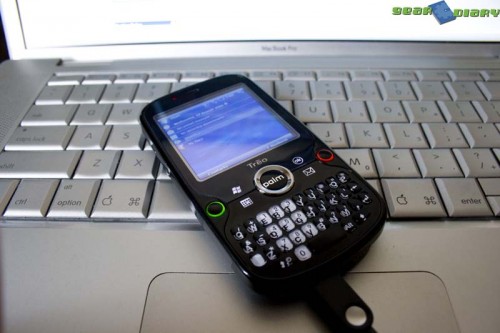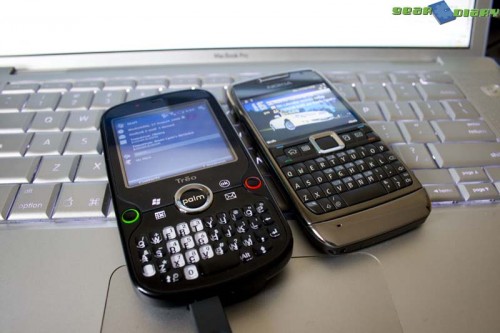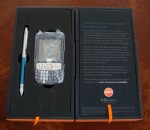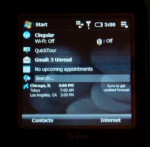Today I received a device that could really be a make-or-break product for a company that has been stagnate for quite some time. The Palm Treo Pro really needs to be successful for Palm, as their current line-up leaves a lot to be desired.
First off I’ll start with the packaging. Like the box the HTC Touch Diamond comes in, the Treo Pro packaging has a corner lopped off. Why? No idea. It is quite nicely presented though, with the device on display as soon as you take the top off.
Included in the sales package is the Treo Pro, a microUSB cable (seems to becoming popular), USB AC adaptor, stereo earphones (3.5mm, woohoo!) and a few manuals and guides. Like HTC, Palm has cheaped out by including a USB AC Adaptor that you plug the USB cable into. With a miniUSB cable that’s not so bad, they are everywhere and can extras can easily be purchased, but the microUSB isn’t overly common yet, so many buyers will find themselves swapping the cable between their computer and AC adaptor. If you find yourself needing an extra one, the microUSB cables that you get for the latest Nokia’s will do the trick.
For those who haven’t been paying attention, the specs of the Treo Pro are as follows:
- Windows Mobile 6.1
- Tri-band HSDPA (850/1900/2100) and Quadband GSM (850/900/1800/1900)
- 320×320 Touchscreen
- GPS
- WiFi
- Bluetooth 2.0+EDR
- 256MB storage (100MB available)
- 128MB RAM
- 1500mAh Battery
- Integrated thumboard
- 2.0 megapixel Camera
- microSDHC slot
- microUSB (Power/Data)
- 3.5mm headset jack
My first thought upon seeing the Treo Pro in the flesh was “uh oh, that keyboard doesn’t look too good”. It’s the same keyboard as on the Palm Centro (which I’ve never used), and straight off the bat I have a bad feeling about it. The key feel isn’t very nice, the travel is very small, they keys themselves are tiny, and they are very close together. The E71 has been my phone for about a month now, and in comparison the Treo Pro is awful. The keyboard on the Treo 750 is considerably better than it. This is a first impressions article though, so I’ll leave my final thoughts on that to the review.
The screen is flush with the front of the device, which is fantastic. Another thing that HTC has begun doing with their devices, and it really makes it a lot easier to keep clean, no gunky edges. You’ll note that I’ve mentioned HTC quite a few times already, and there is a reason for that: the Treo Pro is made by HTC, which is probably a good thing. HTC has been making Windows Mobile devices for quite some time now, and has produced some of the best.
Thankfully Palm saw the error of the WM Treo’s ways and ditched the calculator-watchesque 240×240 display for the same 320×320 display as the Palm OS Treos. It seems to be a beauty too, with rich colours, good brightness and a crispness that was lacking from the 240×240 models. It’s very touch sensitive, which is an excellent touch these days when competitors like the iPhone are around. I can see the stupidly small stylus staying in it’s slot most of the time, as navigation with a fingertip is easy, and the hardware keys help to keep it a one-handed affair most of the time.
Design-wise, I’m not overly fanatical, it just looks too wide. It’s not really, only being a hair wider than the E71, but the flat face seems to accentuate the widths. The glossy black is in line with the current phone trends, and the curvy back is quite nice in the hand. Along the sides are the volume controls, a user-assignable button and a WiFi toggle, all of which are almost flush with the case. Instead of tacky silver plastic, they have a dark chrome look, which is nice. Oddly you’ll find an IR window below the WiFi toggle, someone needs to let the manufacturers in on a little secret: NOBODY USES IRDA ANYMORE.
Up top is Palm’s signature ringer toggle, allowing one to instantly silence the phone and activate vibrate alerts, without having to even look at the phone. It’s a great idea, especially if you happen to forget to do it before going into a meeting or class, shutting up the phones stupid default ringer is an easy task.
Camera on the back is typical Palm: absolute crap. No auto-focusing, no flash, no resolution. The pathetic two-megapixel shooter is sure to be a disappointment, just like all previous Treos.
I didn’t want to comment too much on this before the review, but it’s too important not to. By the looks of it, the 3G radio in the Treo Pro is EXCELLENT. As some will recall from my review, the Touch Diamond was barely able to get a signal in my bedroom (I must live in a black hole?), but the Treo Pro has not lost it once in the few hours I’ve had it. I’d go as far as to say that in my limited testing, it’s holding it’s own against my Nokias! I’m really hoping that this thing performs well as a phone, because if it doesn’t then there really is no point to it.
This is the first Treo to have built-in WiFi and GPS, a must-have feature in a smartphone these days. I don’t use WiFi a lot, but I do use GPS quite a bit on my E71, and I’m looking forward to trying it out on the Treo. The Telstra-branded model I have didn’t include mapping software, but Google Maps looks to work just fine.
Stay tuned for my review of the Treo Pro, I’m just hoping it will be a positive one!
Update: Additional photos of the Treo 800w, Treo Pro, and Centro in the gallery were provided by TT.















The reason Palm didn’t originally offer a 320by 320 display before on a WM device was (supposedly) that (at the time) the OS only had 4 video modes it supported at the time, QVGA, VGA, 240by240 (square) and 480by480. There was no support for 320 by 320. That would have been WM 5.0.
Also – pdadb.net is reporting that the IRDA is SIR/CIR which means it should be strong enough to control devices (assuming you have the prropriate remote control software). SIR only won’t work with controlling consumer devices, but CIR will.
This device actually looks bigger/wider than the Centro so I suspect the keyboard isn’t exactly the same. Mitchell – is it the rubber keys (like the Centro) or is it harder plastic like the Treo 750? The layout is clearly not the same as the Treo 700.750, though.
I think more info about syncing will be good since the majority of people in the world using email are NOT using MS Exchange.
WiFi functionality is going to continue to be more important especially now that mobile Safari and Opera 9.5 have raised the bar. Stats are already showing a dramatic increase in the use of mobile devices for web browsing (via clipping, streaming, or full browsing is unclear), but Internet access is up and the need for speed is up! It’s very nice to finally see WiFi on a Treo.
Ah you young bucks and your healthy thumbs! ;D Cool phone though! 😀
I did get to look at a dummy model the other day, and do have some severe trepidation about the keyboard, so anxious to hear on that one.. The size wasn’t bad, not too fat like Motorola Q9 and not too long like iPhone. A bit shiny for my taste, but ahh a good case is all that takes.. 🙂
Thanks for those points Chris!
I downloaded a universal remote application but it just crashes on the Treo so I have no way to test the IR, but I can’t see anywhere that it says it’s Consumer IR. I’ve scoured the manual to no avail.
It is a bit wider, and the keyboard may be slightly wider, but the difference would be negligible, and in the end it isn’t enough: it’s too cramped. Keys are quite hard, not spongy, but they have almost no feel when pressed, very disappointing. The Treo 750 keyboard was considerably better.
In regards to syncing, I have to disagree with you there. Since this device is really marketed at business people, I think the majority of users would be linking up to Exchange servers or some other form of wireless syncing. I will be giving it a go at local syncing though, for those who still like that antiquated way of backing up their info 😛
WiFi works well on the Treo, but I haven’t really used WiFi on a device in over a year. HSDPA all the way!! Still, WiFi just has to be part of a business-class device like this, especially for those who travel and want to use WiFi hotspots as opposed to pricey international data rates!
Drew: I’m not impressed by the keyboard at all. It is very small and has almost no feel when you press the keys. I was making mistakes constantly, something I never experience on the E71.
Size is fine, not much thicker than the E71, they did get this bit right!!
I’m going to try and get hold of a Palm Centro for comparison, since people may have tried it out before.
I got the CIR/SIR info from pdadb.net, but it’s possible they are not correct.
And you are correct that the majority of business people (over 70%) do use Exchange for email, but the majority of total email users, do not. That’s why I think it’s important to also test agains non-Exchange-type services and not ignore standard Syncing.
I’m not sure (at least in the U.S.) how many businesses vs. non-business type users will purchase this, especially since it has no carrier backing here. That means it may see very little business acceptance – at least here in the U.S. and tha majority of purchasers here might be consumers who would otherwise consider the Diamond or Touch Pro.
I believe Telstra has an exclusivity agreement on it here, which pretty much rules it out for most consumers. Telstra’s prices are considerably higher than the other carriers here, and it won’t be cheap. The E71 can be had on a $49 plan for free ($350 value of calls/SMS per month), the Treo Pro looks like it will be on an $80 plan ($80 inc. calls/SMS).
A 2 megapixel camera? a 320 x 320 pixel screen? Have we gone back in time? Some of the specs are pretty good but was it really not possible for Palm to fork out for a 5MP camera and a decent screen?
Well it’s mainly targetted for business users, so maybe the camera isn’t too much of a problem. The next step in square is 480×480 for Windows Mobile. That’s kinda expensive to do…
Hey Mitchell! Inquiring minds? 😀
Yeah, been severely short on time recently, final got a lump of assignments out of the way, so it’s on track for publishing this week, as is the Blackberry Bold review!